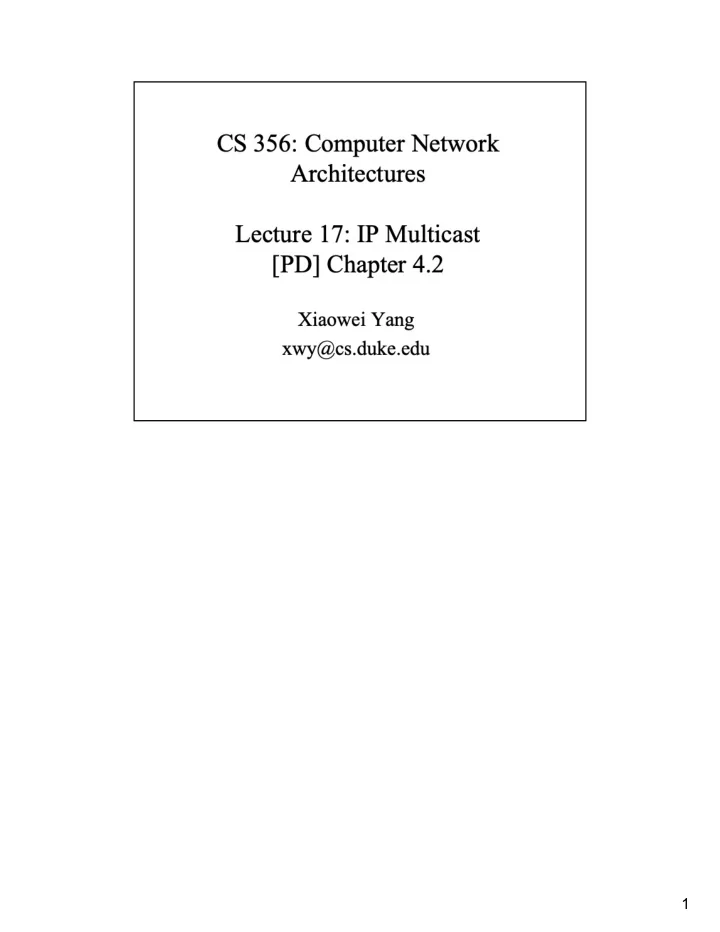

1
https://www.cisco.com/c/en/us/about/press/internet-protocol-journal/back- issues/table-contents-3/ipj-archive/article09186a00800c851e.html 2
3
4
1. Internet radio, tv broadcast, pub/sub, news, stock quotes.. 2. Packet duplication, app needs to track all recipients 5
6
7
8
http://www.iana.org/assignments/ethernet-numbers In the normal Internet dotted decimal notation this is 0.0.94 since the bytes are transmitted higher order first and bits within bytes are transmitted lower order first. 33-33-00-00-00-00 to 33-33-FF-FF-FF-FF are used for IPv6 multicast
10
11
12
13
14
15
Thus, whenever it receives a multicast packet from source S, the router forwards the packet on all outgoing links (except the one on which the packet arrived) if and only if the packet arrived over the link that is on the shortest path to S (i.e., the packet came from the NextHop associated with S in the routing table). 16
17
18
19
20
21
22
23
After B, a host attached to R1 can send to the tree by tunneling the packet to RP first. But it’s inefficient. So RP will send a source specific Join to R1. RP sends a source specific joint so R1 can sends with native multicast. R4, R5, can send (S,G) to build a source specific tree. To do so, it constructs a packet with the appropriate multicast group address as its destination and sends it to a router on its local network known as the designated router (DR). Suppose the DR is R1 in Figure 4.14. There is no state for this multicast group between R1 and the RP at this point, so instead of simply forwarding the multicast packet, R1 tunnels it to the RP. That is, R1 encapsulates the multicast packet inside a PIM Register message that it sends to the unicast IP address of the RP. Just like a tun- nel endpoint of the sort described in Section 3.2.9, the RP receives the packet addressed to it, looks at the payload of the Register message, and finds inside an IP packet addressed to the multicast address of this group. The RP, of course, does know what to do with such a packet—it sends it out onto the shared tree of which the RP is the root. In the example of Figure 4.14, this means that the RP sends the packet on to R2, which is able to forward it on to R4 and R5. The complete delivery of a packet from R1 to R4 and R5 is shown in Figure 4.15. We see the tunneled packet travel from R1 to the RP with an extra IP header containing the unicast address of RP, and then the multicast packet addressed to G 24
making its way along the shared tree to R4 and R5. 24
25
A router state (S,G) is created. Native multicast packets can be sent to RP. 26
Later, R4 and R5 sent join messages so each router creates a (s,G) forwarding state. RP Is not involved anymore. 27
28
29
30
A hierarchical design similar to intra- and inter-domain routing protocols Each domain runs PIM-SM internally RPs of each domains form an overlay mesh using TCP connection (similar to BGP sessions) An RP periodically broadcasts active sources to peer RPs: (S,G) Reverse path forwarding A peer RP that has active receivers sends join to S on behalf of the receivers If an MSDP peer RP that receives one of these broadcasts has active receivers for that multicast group, it sends a source-specific Join, on that RP’s own behalf, to the source host, as shown in Figure 4.16(a). The Join message builds a branch of the source-specific tree to this RP, as shown in Figure 4.16(b). The result is that every RP that is part of the MSDP network and has active receivers for a particular multicast group is added to the source-specific tree of the new source. When an RP receives a multicast from the source, the RP uses its shared tree to forward the multicast to the receivers in its domain.
32
https://tools.ietf.org/html/rfc3170 https://en.wikipedia.org/wiki/IP_multicast#Development 33
34
35
36
37
38
39
In the hourglass Internet architecture, -IP is the compatibility layer in the Internet architecture. -All hosts must implement IP -Two choices -multicast at IP -or application: only a subset, customizability One important architecture question is, at which layer should multicast be implemented. The convention wisdom has been to support multicast in the IP layer for efficiency and performance reasons. However, more than 10 years since this is proposed, it still has not been widely deployed. This paper revisits this question with emphasis on Internet evaluation. In particular, we show that multicast at the application layer can be efficient compared to IP Multicast. 40
Recently, we and others have advocated for an alternative architecture, where all multicast functionality, including pkt replication and group management are pushed to end systems. - We call this architecture End System Multicast - In this architecture, end system organize themselves into an overlay tree root at the source - data is sent along the overlay tree. - It is an overlay in the sense that each link in the overlay tree corresponds to a physical path in the underlying network 41
42
43
44
45
Recommend
More recommend